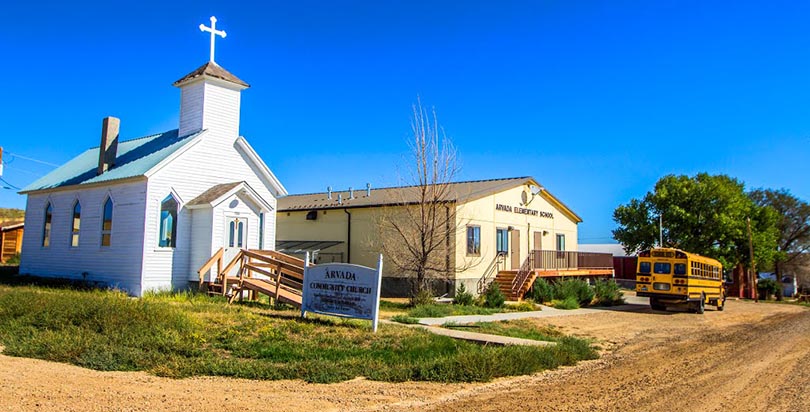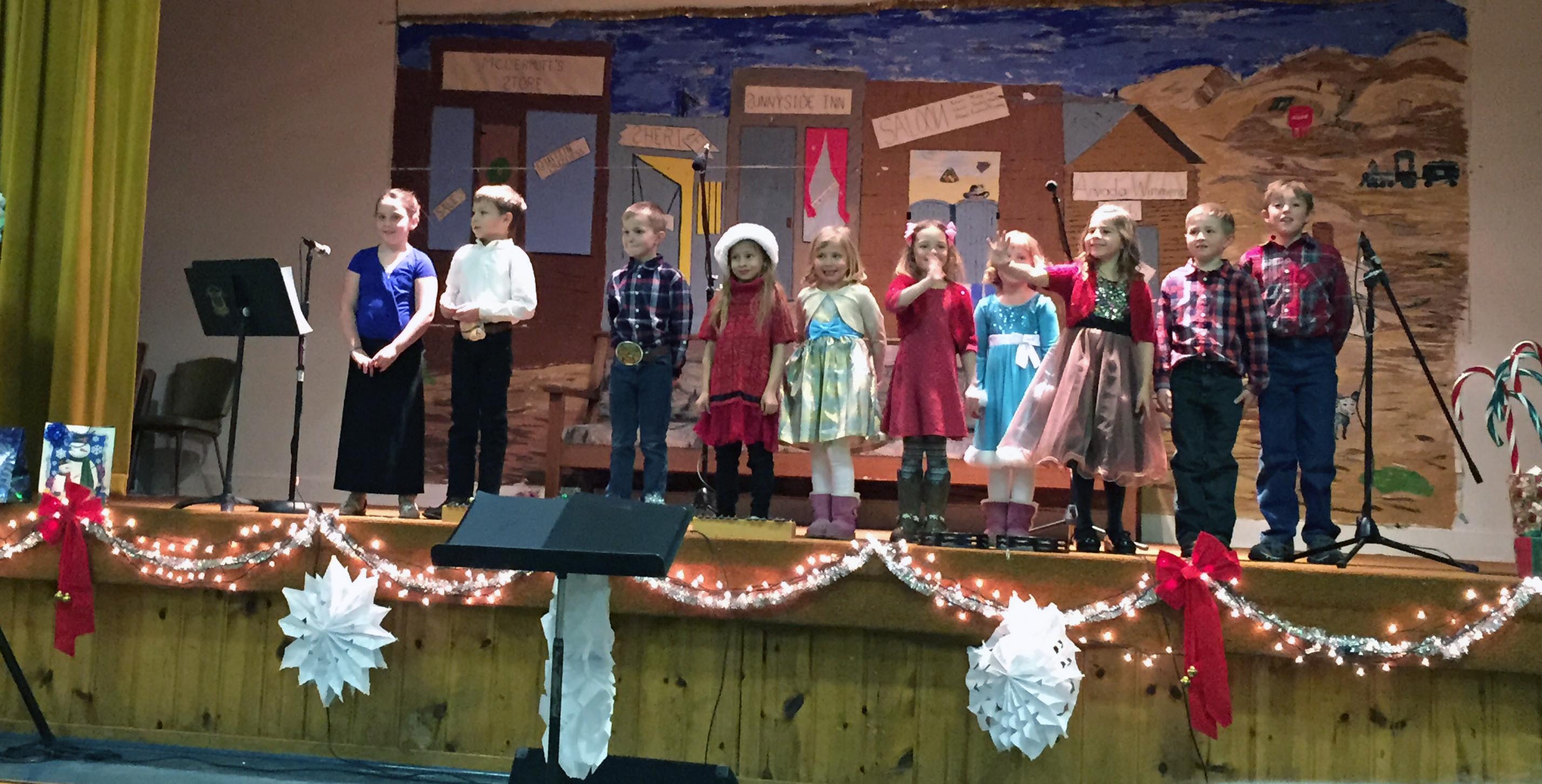10 Kids + 1 Teacher = The Smallest School in the Tiniest District in America’s Least Populated State

Brindle and Bronc Vineyard are lucky. Every school day, the young children wake up at 6 o’clock, eat a hot country breakfast, scrub the syrup off their teeth, and hop into a school Suburban that pulls up next to their rural Wyoming cattle ranch.
A few miles down the highway, the Suburban turns down a gravel road and pulls up to the yellow, two-room schoolhouse in Arvada, population 43.
First-grader Brindle, who is 6, and her 9-year-old brother, who is in third grade, are two of only 10 children at Arvada Elementary School — the smallest school in the smallest district in America’s least-populated state. With fewer than a dozen kids, it’s safe to say Arvada saw a population surge this year: Last year, only four children were enrolled in the K-4 school, where the full-time faculty consists of one teacher and a paraprofessional.
Not all kids at Arvada, and at the district’s other school, a 95-student K-12 campus 20 miles away in Clearmont, have it as easy as Brindle and Bronc. For some of them, including those who live on ranches up north near the Montana state line, the commute can take more than an hour each way.
Every morning, said Charles Auzqui, Sheridan County School District 3 superintendent, district-owned Suburbans — which can handle bumpy country roads — pick up kids along feeder routes and eventually meet up with school buses that haul the students the rest of the way.
It’s a long trip for young children to make. But if the schools in Clearmont and Arvada didn’t exist, many families wouldn’t be able to send their kids to public school at all. Larger towns with more resources, like Gillette and Sheridan, are more than 50 miles away.
“Sometimes the question of whether a school stays open depends on whether we still have kids,” Auzqui said. “I always see the need for one education institution. Arvada can sustain the 10 kids down there, but if there are limited numbers, it would be hard to defend having a rural elementary school.”
The Arvada school may be small, but every child — even in the “middle of nowhere” — deserves access to a high-quality education, said Amy Vineyard, Brindle and Bronc’s mother, who also serves as chairwoman of the school district’s board of trustees.
This year, however, education officials in Arvada and in rural communities across the state are uneasy. Wyoming faces a budget shortfall, and significant education funding cuts look likely — a situation that Vineyard said could prompt “a different turn in our school system.”
Nationally, as a focus on the federal level zeroes in on school choice, rural educators fear they’re being left out of the dominant policy conversation. In most parts of the state, alternatives like charter or private schools simply don’t exist. And if choices like virtual schools are incentivized, rural educators worry they could harm their districts.
“The small schools are important for these little kiddos to get their quality education,” Vineyard said. “Taking them out just puts more stress on the kiddos, more stress on the families.”
‘Middle of nowhere’
Beyond wide-open spaces and welcoming communities, the towns of Arvada and Clearmont don’t offer much. Next door to the Arvada school is a small church, but it no longer offers religious services, Vineyard said. There’s a trailer park, a post office, and a bar that’s Arvada’s only café. Clearmont, with a population of about 140, is only slightly bigger. It has a vibrant church and a gas station that offers basic grocery items.
“They’ve got eggs and milk and stuff like that,” Vineyard said. “But you can’t go and get Cap’n Crunch or fresh vegetables or stuff that you’d be able to get at a regular grocery store.” For that, residents have to drive to Gillette or Sheridan.
Arvada Elementary also has its limits. Students in kindergarten and first and second grades are taught in one classroom, third- and fourth-graders in the other, she said. With only one teacher, the paraprofessional is a crucial helping hand. On average, the principal, who leads both district schools, travels to Arvada about once a week. That makes handling disciplinary problems a challenge. If something happens, the teacher and para have to address the problem on their own — or wait for the principal.
“There is some uniqueness to it, yet they are still very supported,” Auzqui said. “It’s just, sometimes, it’s a 20-to-25-minute drive to be down there.”
Beyond core subjects like math, English, and science specific to each grade level, students at Arvada have access to electives like physical education and art — taught by teachers who travel from Clearmont twice a week. In order to avoid absences because of school sports and other activities, the district runs on a four-day week, with extracurriculars on Fridays and Saturdays. Otherwise, huge swaths of students could be absent due to simple activities, like a midweek volleyball game.
All told, the district — which spans 1,300 square miles of rugged Wyoming countryside — employs 16 certified teachers, with average class sizes between seven and nine kids. Graduating classes have ranged from four to 12 students.
Sure, the schools are small, Vineyard said, but she can’t think of anything better for her children.
“If you look at some bigger schools, there’s lots and lots of kids and you have one teacher in there. They’ve got a lot to do,” she said. “My kids go up there and their education is just like a one-on-one type of situation.”
Money woes
For decades, Wyoming schools have benefited from education spending unmatched by most states, propelled in part by a state Supreme Court ruling that found an equitable education to be a constitutional right for every student. The state’s natural resources also have been a boon for its schools.
But as the state braces for an economic crisis driven by a downturn in the fossil fuel industry, Wyoming’s school system faces a funding shortfall that could reach $400 million annually by 2021.
Lawmakers in both the House and Senate are considering bills to address the issue, which could impose a sales tax hike, freeze transportation spending, or cut school district block grants. Additionally, a budget amendment could require $91 million in education cuts next year.
Districts across the state are feeling a money crunch, a state education department spokeswoman said, and Auzqui is tracking how cuts could affect his schools. Two years ago, as state lawmakers worked to recalibrate the funding formula, Auzqui formed a coalition with education leaders from three comparable districts. For extremely remote districts with fewer than 120 kids, a funding formula based on student enrollment isn’t sufficient, he said, and to compensate, the state offers a “small school district adjustment.”
Now, as lawmakers look to slash funding, the coalition meets monthly to discuss its districts’ specific challenges. “The impact of the decisions they’re making at the state level can be tremendous,” Auzqui said. “So we want to make sure we’re communicating and the acts they’re voting on are fair for us as small communities.”
What choice?
During the presidential campaign, Donald Trump put down a marker on school choice, proposing $20 billion in federal aid to help low-income families choose their children’s schools. His secretary of education, Betsy DeVos, has spent her career promoting alternatives to traditional public schools.
While DeVos’s confirmation process was rockier than Wyoming’s Bighorn Mountains — and her comments about guns and grizzly bears in Wyoming schools may forever be the subject of standup comedy routines — her January 18 hearing in the U.S. Senate brought to light substantive questions about the role of school choice in the most remote corners of America.
About one-third of public schools in the United States are located in rural areas, according to data from the National Center for Education Statistics, enrolling about 12 million students, or 24 percent of the total student population, during the 2010–11 school year.

Arvada Elementary School students participate in a Christmas concert at the local community center.
Photo: Photo courtesy Amy Vineyard
Sen. Lisa Murkowski of Alaska — one of only two Republicans who voted against DeVos — said school choice is simply not an option in the most remote parts of her state. Expanding choice options, Murkowski argued, should not come at the expense of traditional public schools.
“I need to have a very clear and a very firm commitment that the focus that you will give, to not only Alaska but to states that have significant rural populations, that these students who will not have alternatives, that that public school system is not undermined, eroded, or ignored,” Murkowski said.
Sen. Mike Enzi, a Republican from Wyoming, voiced a similar concern. Noting that rural and frontier schools in his state have “special problems,” Enzi asked DeVos about her plan to engage rural communities in the federal Every Student Succeeds Act implementation process.
After giving a nod to local control in education, she pivoted back to school choice — online schools, specifically. “When we think about the future, I think about the opportunity for more choices and options for those parents at a distance-learning type of a situation and the possibility that course choices or online courses could be offered in ways that they may not have been previously,” she said.
Enzi ultimately voted to confirm DeVos — but Vineyard had asked him not to. In an email, she said the secretary’s background in education policy wouldn’t benefit Wyoming schools. Although she knows a few families in the area who homeschool their children, and online programs are an option, she said her kids need opportunities to socialize with other people. Their closest neighbor lives 5 miles away.
“We’re in the middle of nowhere. We’re 50 miles from everywhere,” she said. “I think it’s super beneficial for kids when they go to school, they’ve got to deal with people every day who they may or may not like.”
Auzqui, on the other hand, said he will wait to see how DeVos performs before passing judgment. Though two statewide online public K-12 schools already exist in Wyoming, he said other alternatives could come with risks for the district.
“Parents always have those options, and those are things that we have to take into consideration every year as we’re budgeting,” he said.
Allen Pratt, executive director of the National Rural Education Association, a nonprofit advocacy group based at the University of Tennessee at Chattanooga, said educators around the country are having similar conversations about what DeVos and a big school-choice push could mean for remote schools. Charter schools just aren’t a feasible option in a lot of rural communities, he said. In regard to virtual learning opportunities, Pratt noted that rural areas often don’t have access to broadband that meets online course requirements.
Still, as DeVos begins her tenure at the federal Department of Education, Pratt expressed optimism.
“The rural voice did make a major impact on this election,” he said, noting the large turnout for Trump in less populated parts of the country. “We have to use this momentum and do what we need to do to help rural schools.”
Added Pratt, “You have to be positive right now. We’ll do the best we can, and if there’s more freedom and flexibility for departments of ed at each state level, maybe that’s a good thing.”
The Dick & Betsy DeVos Family Foundation provided funding to The 74 from 2014 to 2016. Campbell Brown serves on the boards of both The 74 and the American Federation for Children, which was formerly chaired by Betsy DeVos. Brown played no part in the reporting or editing of this article.
Get stories like these delivered straight to your inbox. Sign up for The 74 Newsletter

;)
